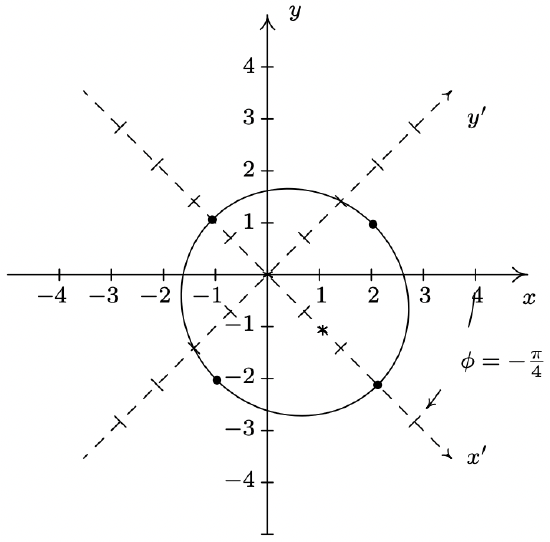11.6E: Exercises
- Page ID
- 120678
\( \newcommand{\vecs}[1]{\overset { \scriptstyle \rightharpoonup} {\mathbf{#1}} } \)
\( \newcommand{\vecd}[1]{\overset{-\!-\!\rightharpoonup}{\vphantom{a}\smash {#1}}} \)
\( \newcommand{\id}{\mathrm{id}}\) \( \newcommand{\Span}{\mathrm{span}}\)
( \newcommand{\kernel}{\mathrm{null}\,}\) \( \newcommand{\range}{\mathrm{range}\,}\)
\( \newcommand{\RealPart}{\mathrm{Re}}\) \( \newcommand{\ImaginaryPart}{\mathrm{Im}}\)
\( \newcommand{\Argument}{\mathrm{Arg}}\) \( \newcommand{\norm}[1]{\| #1 \|}\)
\( \newcommand{\inner}[2]{\langle #1, #2 \rangle}\)
\( \newcommand{\Span}{\mathrm{span}}\)
\( \newcommand{\id}{\mathrm{id}}\)
\( \newcommand{\Span}{\mathrm{span}}\)
\( \newcommand{\kernel}{\mathrm{null}\,}\)
\( \newcommand{\range}{\mathrm{range}\,}\)
\( \newcommand{\RealPart}{\mathrm{Re}}\)
\( \newcommand{\ImaginaryPart}{\mathrm{Im}}\)
\( \newcommand{\Argument}{\mathrm{Arg}}\)
\( \newcommand{\norm}[1]{\| #1 \|}\)
\( \newcommand{\inner}[2]{\langle #1, #2 \rangle}\)
\( \newcommand{\Span}{\mathrm{span}}\) \( \newcommand{\AA}{\unicode[.8,0]{x212B}}\)
\( \newcommand{\vectorA}[1]{\vec{#1}} % arrow\)
\( \newcommand{\vectorAt}[1]{\vec{\text{#1}}} % arrow\)
\( \newcommand{\vectorB}[1]{\overset { \scriptstyle \rightharpoonup} {\mathbf{#1}} } \)
\( \newcommand{\vectorC}[1]{\textbf{#1}} \)
\( \newcommand{\vectorD}[1]{\overrightarrow{#1}} \)
\( \newcommand{\vectorDt}[1]{\overrightarrow{\text{#1}}} \)
\( \newcommand{\vectE}[1]{\overset{-\!-\!\rightharpoonup}{\vphantom{a}\smash{\mathbf {#1}}}} \)
\( \newcommand{\vecs}[1]{\overset { \scriptstyle \rightharpoonup} {\mathbf{#1}} } \)
\( \newcommand{\vecd}[1]{\overset{-\!-\!\rightharpoonup}{\vphantom{a}\smash {#1}}} \)
Graph the following equations.
- \(x^{2}+2 x y+y^{2}-x \sqrt{2}+y \sqrt{2}-6=0\)
- \(7 x^{2}-4 x y \sqrt{3}+3 y^{2}-2 x-2 y \sqrt{3}-5=0\)
- \(5 x^{2}+6 x y+5 y^{2}-4 \sqrt{2} x+4 \sqrt{2} y=0\)
- \(x^{2}+2 \sqrt{3} x y+3 y^{2}+2 \sqrt{3} x-2 y-16=0\)
- \(13 x^{2}-34 x y \sqrt{3}+47 y^{2}-64=0\)
- \(x^{2}-2 \sqrt{3} x y-y^{2}+8=0\)
- \(x^{2}-4 x y+4 y^{2}-2 x \sqrt{5}-y \sqrt{5}=0\)
- \(8 x^{2}+12 x y+17 y^{2}-20=0\)
Graph the following equations.
- \(r=\frac{2}{1-\cos (\theta)}\)
- \(r=\frac{3}{2+\sin (\theta)}\)
- \(r=\frac{3}{2-\cos (\theta)}\)
- \(r=\frac{2}{1+\sin (\theta)}\)
- \(r=\frac{4}{1+3 \cos (\theta)}\)
- \(r=\frac{2}{1-2 \sin (\theta)}\)
- \(r=\frac{2}{1+\sin \left(\theta-\frac{\pi}{3}\right)}\)
- \(r=\frac{6}{3-\cos \left(\theta+\frac{\pi}{4}\right)}\)
The matrix \(A(\theta)=\left[\begin{array}{rr} \cos (\theta) & -\sin (\theta) \\ \sin (\theta) & \cos (\theta) \end{array}\right]\) is called a rotation matrix. We’ve seen this matrix most recently in the proof of used in the proof of Theorem 11.9.
- Show the matrix from Example 8.3.3 in Section 8.3 is none other than \(A\left(\frac{\pi}{4}\right)\).
- Discuss with your classmates how to use \(A(\theta)\) ) to rotate points in the plane.
- Using the even / odd identities for cosine and sine, show \(A(\theta)^{-1}=A(-\theta)\). Interpret this geometrically.
11.6.4 Answers
- \(x^{2}+2 x y+y^{2}-x \sqrt{2}+y \sqrt{2}-6=0\) becomes \(\left(x^{\prime}\right)^{2}=-\left(y^{\prime}-3\right)\) after rotating counter-clockwise through \(\theta=\frac{\pi}{4}\).
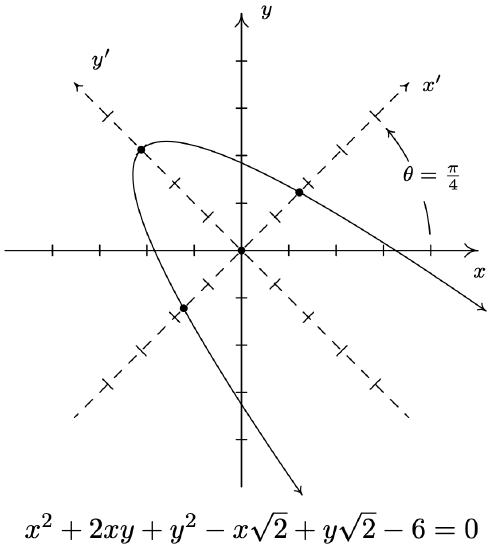
- \(7 x^{2}-4 x y \sqrt{3}+3 y^{2}-2 x-2 y \sqrt{3}-5=0\) becomes \(\frac{\left(x^{\prime}-2\right)^{2}}{9}+\left(y^{\prime}\right)^{2}=1\) after rotating counter-clockwise through \(\theta=\frac{\pi}{3}\)
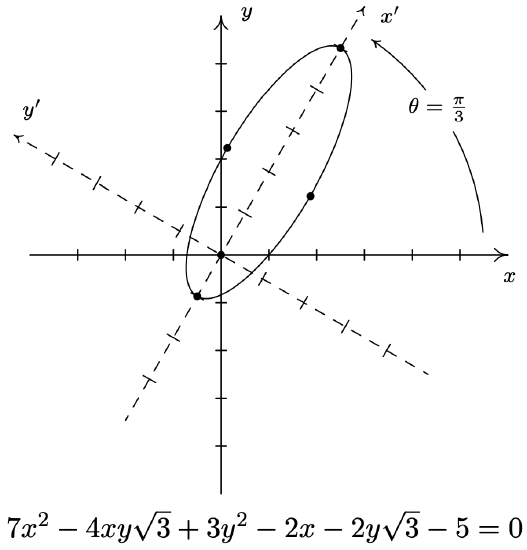
- \(5 x^{2}+6 x y+5 y^{2}-4 \sqrt{2} x+4 \sqrt{2} y=0\) becomes \(\left(x^{\prime}\right)^{2}+\frac{\left(y^{\prime}+2\right)^{2}}{4}=1\) after rotating counter-clockwise through \(\theta=\frac{\pi}{4}\).
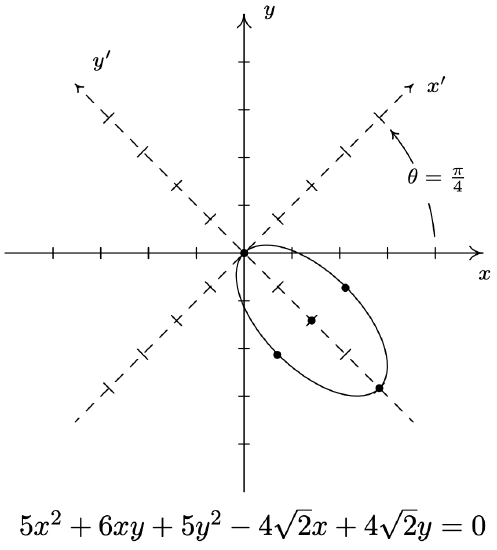
- \(x^{2}+2 \sqrt{3} x y+3 y^{2}+2 \sqrt{3} x-2 y-16=0\) becomes \(\left(x^{\prime}\right)^{2}=y^{\prime}+4\) after rotating counter-clockwise through \(\theta=\frac{\pi}{3}\)

- \(13 x^{2}-34 x y \sqrt{3}+47 y^{2}-64=0\) becomes \(\left(y^{\prime}\right)^{2}-\frac{\left(x^{\prime}\right)^{2}}{16}=1\) after rotating counter-clockwise through \(\theta=\frac{\pi}{6}\).
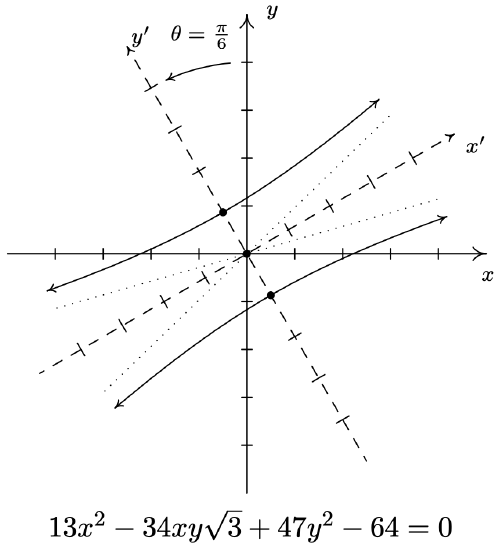
- \(x^{2}-2 \sqrt{3} x y-y^{2}+8=0\) becomes \(\frac{\left(x^{\prime}\right)^{2}}{4}-\frac{\left(y^{\prime}\right)^{2}}{4}=1\) after rotating counter-clockwise through \(\theta=\frac{\pi}{3}\)
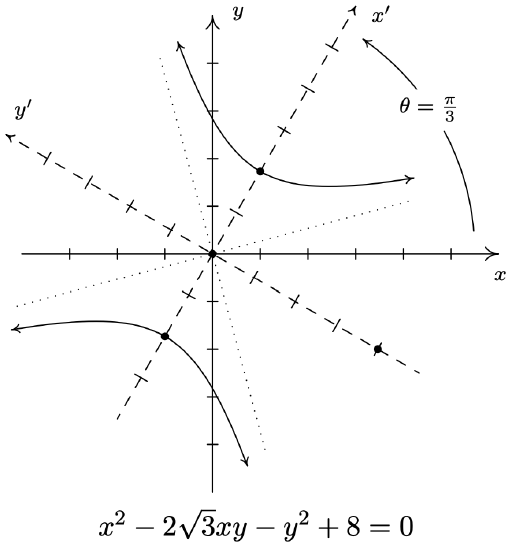
- \(x^{2}-4 x y+4 y^{2}-2 x \sqrt{5}-y \sqrt{5}=0\) becomes \(\left(y^{\prime}\right)^{2}=x\) after rotating counter-clockwise through \(\theta=\arctan \left(\frac{1}{2}\right)\).
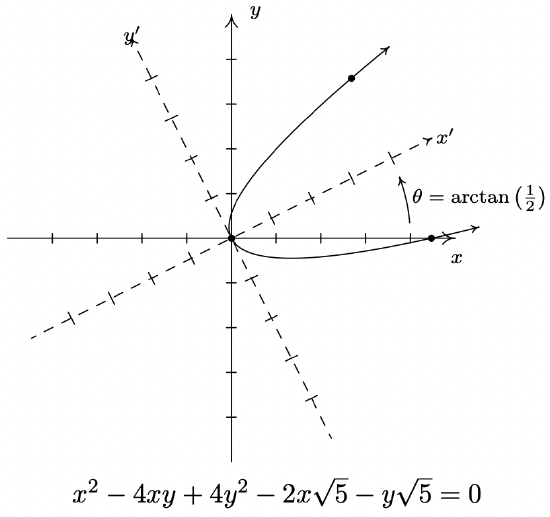
- \(8 x^{2}+12 x y+17 y^{2}-20=0\) becomes \(\left(x^{\prime}\right)^{2}+\frac{\left(y^{\prime}\right)^{2}}{4}=1\) after rotating counter-clockwise through \(\theta=\arctan (2)\)
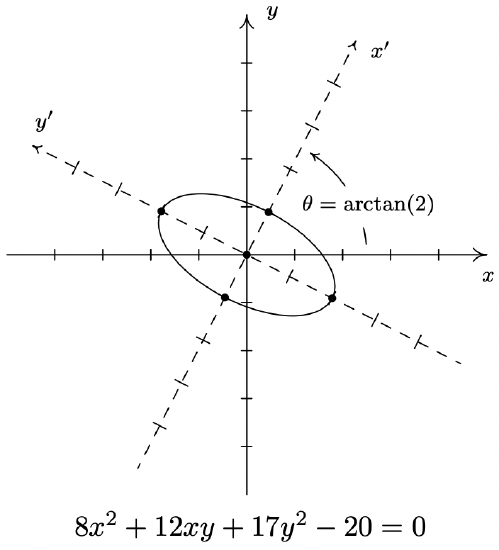
- \(r=\frac{2}{1-\cos (\theta)}\) is a parabola directrix \(x = −2\), vertex (−1, 0) focus (0, 0), focal diameter 4
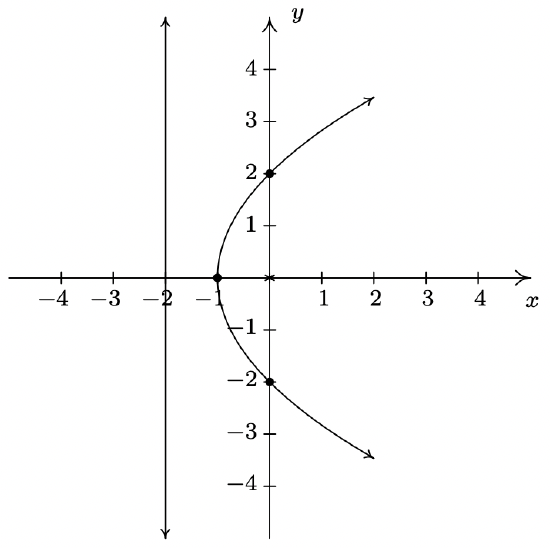
- \(r=\frac{3}{2+\sin (\theta)}=\frac{\frac{3}{2}}{1+\frac{1}{2} \sin (\theta)}\) is an ellipse directrix \(y = 3\), vertices (0, 1), (0, −3) center (0, −2) , foci (0, 0), (0, −2) minor axis length \(2 \sqrt{3}\)
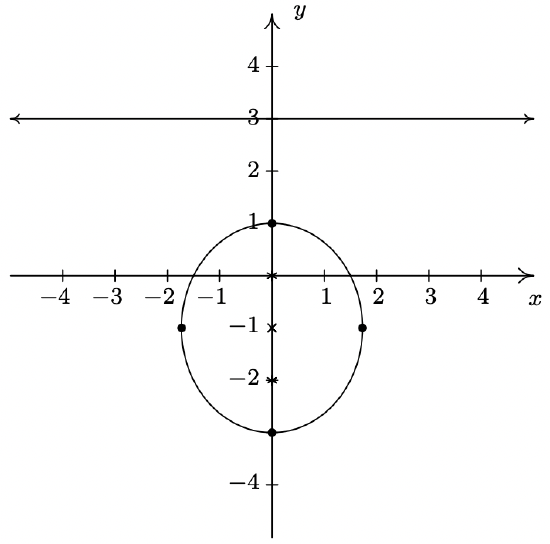
- \(r=\frac{3}{2-\cos (\theta)}=\frac{\frac{3}{2}}{1-\frac{1}{2} \cos (\theta)}\) is an ellipse directrix \(x = −3\), vertices (−1, 0), (3, 0) center (1, 0) , foci (0, 0), (2, 0) minor axis length \(2 \sqrt{3}\)
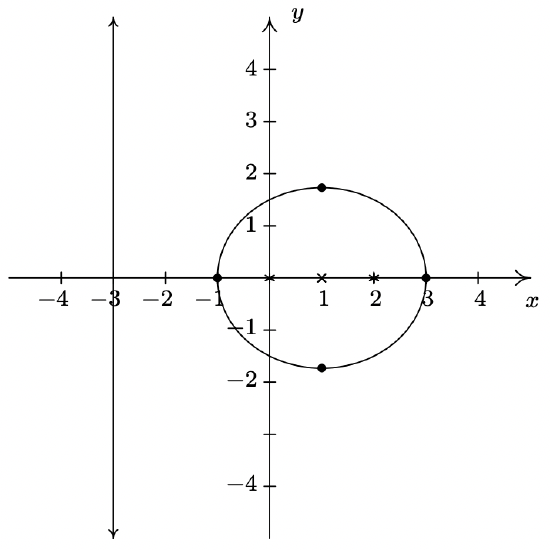
- \(r=\frac{2}{1+\sin (\theta)}\) is a parabola directrix \(y = 2\), vertex (0, 1) focus (0, 0), focal diameter 4
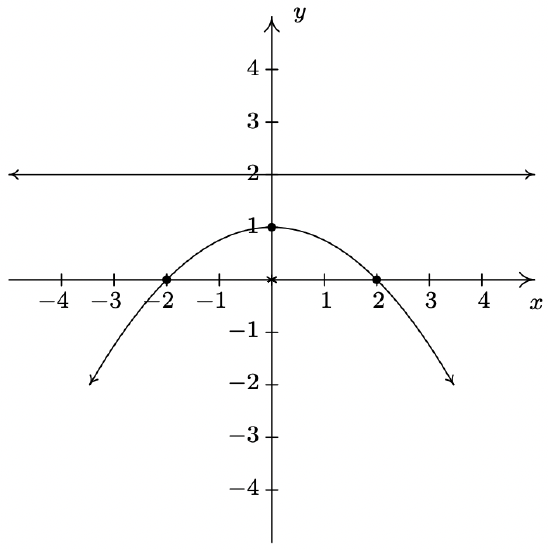
- \(r=\frac{4}{1+3 \cos (\theta)}\) is a hyperbola directrix \(x=\frac{4}{3}\), vertices (1, 0), (2, 0) center \(\left(\frac{3}{2}, 0\right)\), foci (0, 0), (3, 0) conjugate axis length \(2 \sqrt{2}\)
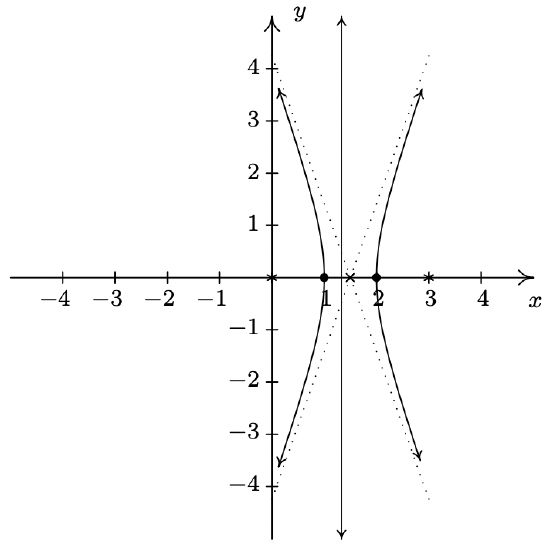
- \(r=\frac{2}{1-2 \sin (\theta)}\) is a hyperbola directrix \(y = −1\), vertices \(\left(0,-\frac{2}{3}\right),(0,-2)\) center \(\left(0,-\frac{4}{3}\right)\), foci \((0,0),\left(0,-\frac{8}{3}\right)\) conjugate axis length \(\frac{2 \sqrt{3}}{3}\)
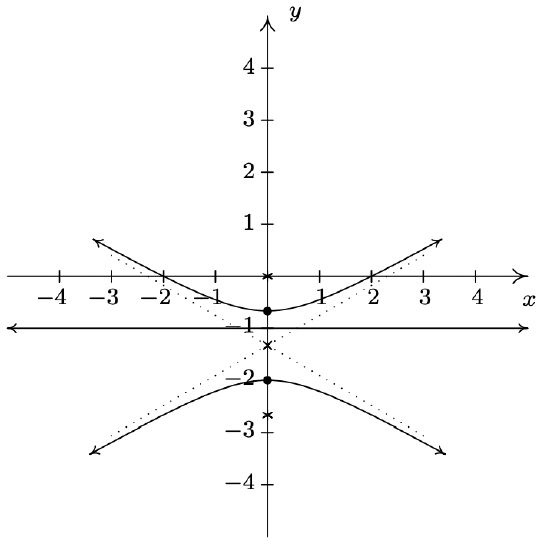
- \(r=\frac{2}{1+\sin \left(\theta-\frac{\pi}{3}\right)}\) is the parabola \(r=\frac{2}{1+\sin (\theta)}\) rotated through \(\phi=\frac{\pi}{3}\)
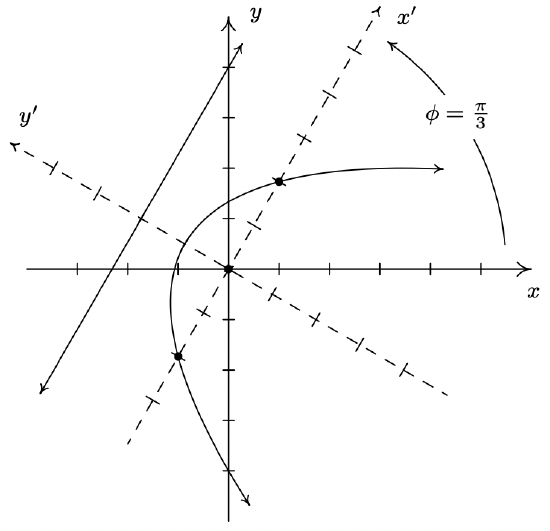
- \(r=\frac{6}{3-\cos \left(\theta+\frac{\pi}{4}\right)}\) is the ellipse \(r=\frac{6}{3-\cos (\theta)}=\frac{2}{1-\frac{1}{3} \cos (\theta)}\) rotated through \(\phi=-\frac{\pi}{4}\)
